SUMMARY
This is AI generated summarization, which may have errors. For context, always refer to the full article.
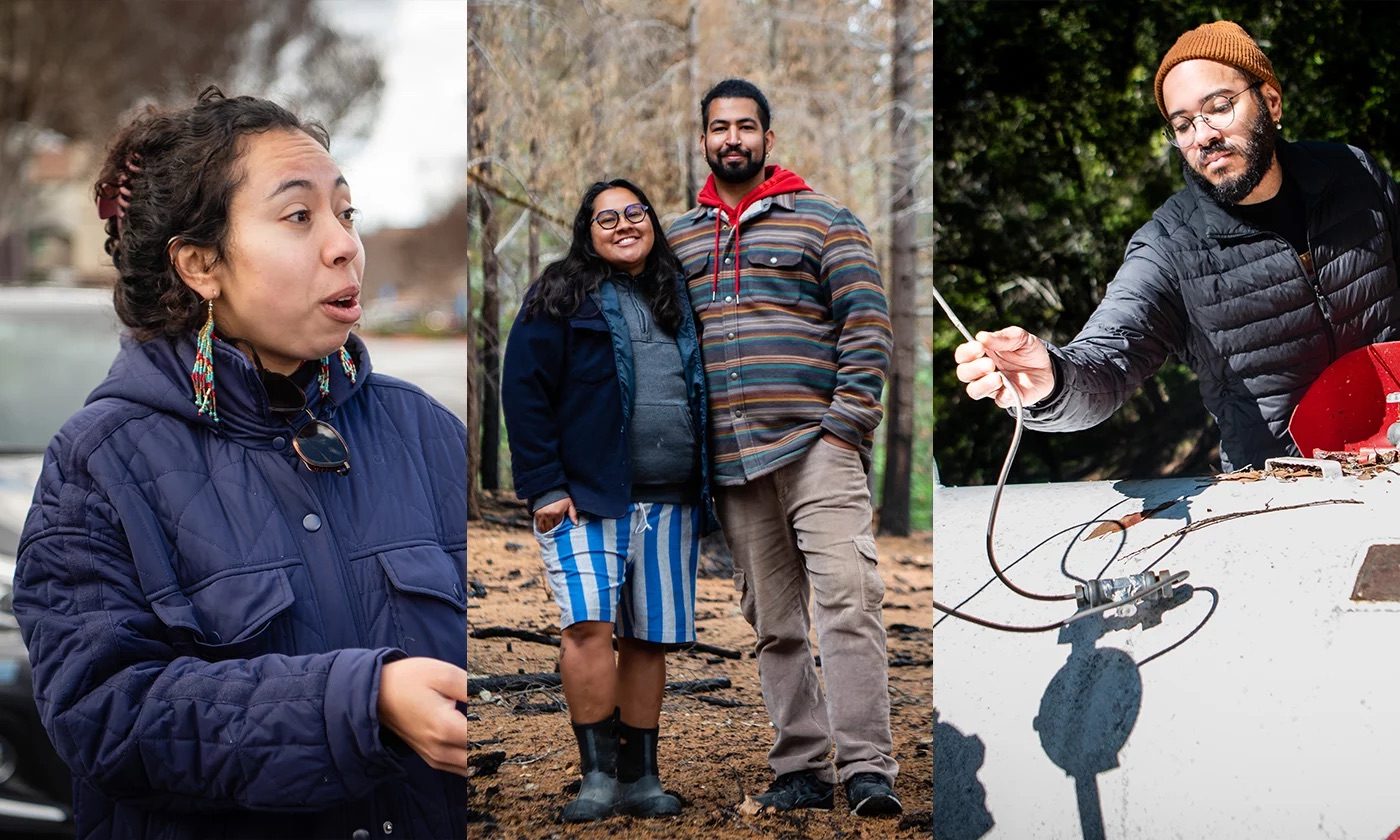
On a cold winter morning deep in the woods of Cazadero, California, Nikola Alexandre adds gasoline to a red Predator 2000 generator, flips on the engine’s switch, and pulls the recoil cord. The generator sputters briefly, then steadily starts to hum.
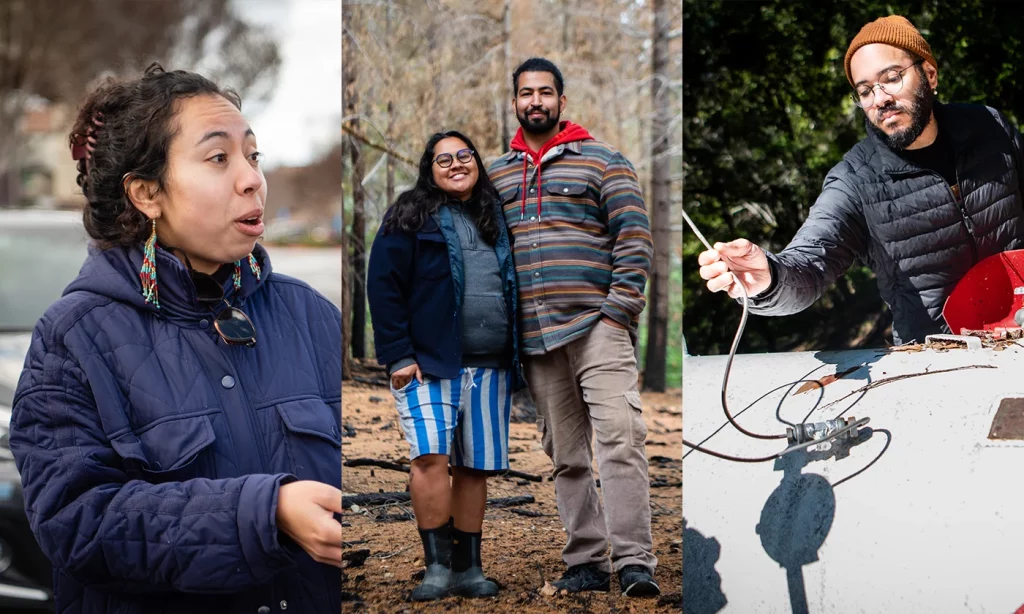
“Our connection to the outside world is satellite internet – so no power, no internet,” Alexandre says. He and others at Shelterwood Collective were left without power for two weeks in early 2023 when massive storms hit California. “We ran the generator two to three hours daily to check in with the outside world and let people know we were OK.”
“We joked that this was the worst-best storm of our lives. The damage is only going to get worse, but our autonomy and ability to respond to it are only going to get better,” Alexandre says. “We hope that as we build up this microgrid, we won’t be as dependent on Pacific Gas and Electric (PG&E), both in the summer when they cut off power because of wildfires, and in the winter when the trees come down on the power lines. We’ll shift from a community that is vulnerable to one that is more independent and sovereign in how our energy is produced and used.”
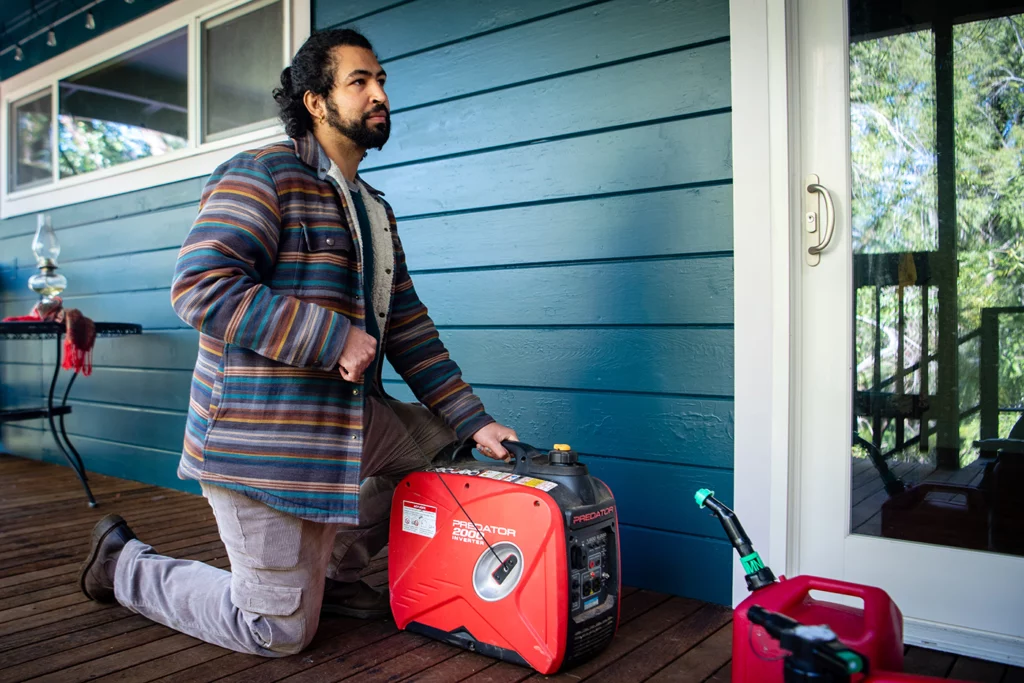
Shelterwood Collective is an Indigenous, Black, and queer-led collective of land protectors and cultural strategists stewarding 900 acres of forest in Northern California. They are among a growing number of organizations and localities trying to wrest control of their energy futures away from behemoth, dirty, and dangerous energy utilities like PG&E, the largest utility in the United States. They try to put decisions about energy production, distribution, and use in the hands of the most impacted communities. For Shelterwood and others, one way to do that is to build community-governed solar microgrids.
PG&E is investor-owned. It serves some 16 million people across 70,000 square miles in Central and Northern California. As a profit-seeking private entity whose shareholders are guaranteed a specific rate of return on investment, PG&E often forgoes spending on essential measures to protect human and ecosystem health. This has resulted in catastrophic wildfires, deadly explosions, power shutoffs for millions of people, escalating rates, expansion of dirty energy projects, and vehement opposition to the increasingly popular move toward community-controlled, renewable energy.
The consequences have been particularly devastating for Indigenous, Black and Brown, disabled, elderly, poor, working-class, and rural communities.
In 2010, PG&E malfeasance caused an explosion in San Bruno, California, blowing a hole in a major city and killing eight people. In 2018, PG&E’s crumbling electrical grid started a fire that ravaged Paradise, also in California, killing 85 people and burning 14,000 homes. Year after year, mega fires – the Dixie, Tubbs, Zogg, and Mosquito fires, each in the top 10 fires in California history – have either been caused by PG&E, or PG&E has been at the center of investigations and settlements surrounding the fires. The utility has admitted some guilt, some investigations are ongoing, there have been settlements without admission of guilt, and the clock is still ticking on some court proceedings.
The company has recouped its losses from these fires by hiking up costs for ratepayers, who already pay among the highest rates in the country. Additionally, instead of completing long-overdue infrastructure repair to minimize wildfires, PG&E has sought to limit its liability for future fires by instituting rolling blackouts during wildfire season, leaving millions throughout the state without power, with little planning to protect communities dependent on power to live.

The ability to have uninterrupted service is particularly important for people with disabilities.
“This week in the Bay Area, disabled people and elders without power are having difficulty breathing, moving, eating, and staying alive,” explained the late disability justice organizer Stacey Park Milbern at a rally outside PG&E’s headquarters during a power blackout in 2019.
“A friend is going without her nebulizer treatment. A neighbor didn’t have a way to store insulin. Another community member is homebound because she needs electricity to open the garage. People are being forced to throw out groceries without knowing where the money will come from to replace them. Blind people are crossing the street without there being traffic lights or audible signals telling them when to cross. Have you tried communicating in American Sign Language in the dark? It’s not easy.”
Milbern continued, “I use life-sustaining medical equipment – my ventilator – 16 hours a day. My doctor completed extensive paperwork telling PG&E why I need power to live. When I called PG&E, I was on hold for two hours. I hadn’t received any notice from PG&E, but my house was on four different maps as losing power. To PG&E, my life is not important.”
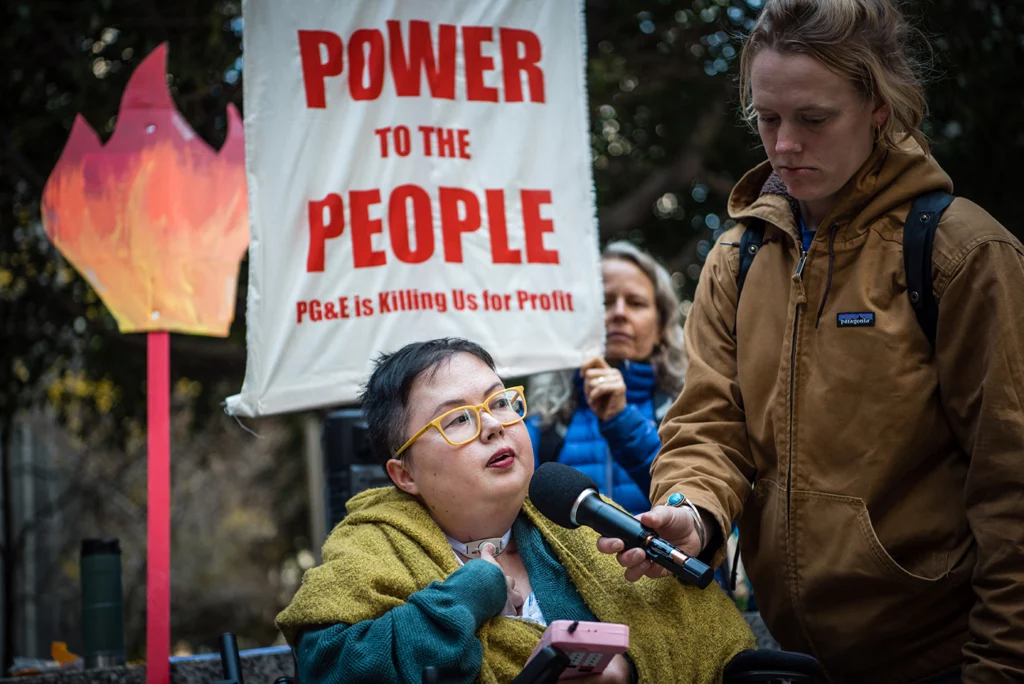
Despite being abandoned by PG&E during the wildfires and planned power outages, disabled activists formed mutual aid networks to survive – making do-it-yourself box-fan filters, distributing KN95 masks, sourcing generators and ice, and buying hotel rooms for those in need of power.
While the consequences are especially stark for disabled people, who’ve long been marginalized in conversations about energy policy, communities everywhere are recognizing that if we need power to live, that power cannot be controlled by a profit-driven monopoly utility. Instead, decisions about energy production, distribution, and use must be made by people with the most at stake in those decisions.
Energy democracy is the fight to shift energy from a resource that has been centralized and commodified by corporations into a shared resource that is decentralized and democratized, resilient and redundant, aligned with the health of local ecosystems, and which meets the needs of workers and communities. It is a key pillar of a larger Just Transition platform.
“Everyone waits in fear of a Wall Street corporation pressing a red button to turn their power on or off,” says Pete Woiwode, co-director of the Reclaim Our Power: Utility Justice Campaign.
“What if we flipped that and the folks who make the decisions about whose needs to prioritize – who has access to life-giving energy – are the folks most vulnerable in these scenarios? Energy can be a process by which we upend generations of horrific injustice and put our lives, livelihoods, and ecosystems at the center.”
Increasingly exasperated with powerful, polluting utility companies, fire survivors, environmental justice communities, and people with disabilities formed Reclaim Our Power to organize for renewable energy, public ownership, and community control. They have repeatedly called on California Governor Gavin Newsom to deny PG&E’s safety certificate, or what advocates have dubbed PG&E’s “license to burn.” Reclaim Our Power’s sister organization, Local Clean Energy Alliance, was essential in creating community choice energy agencies throughout the state, which put the decision about where to procure energy in the hands of local communities.
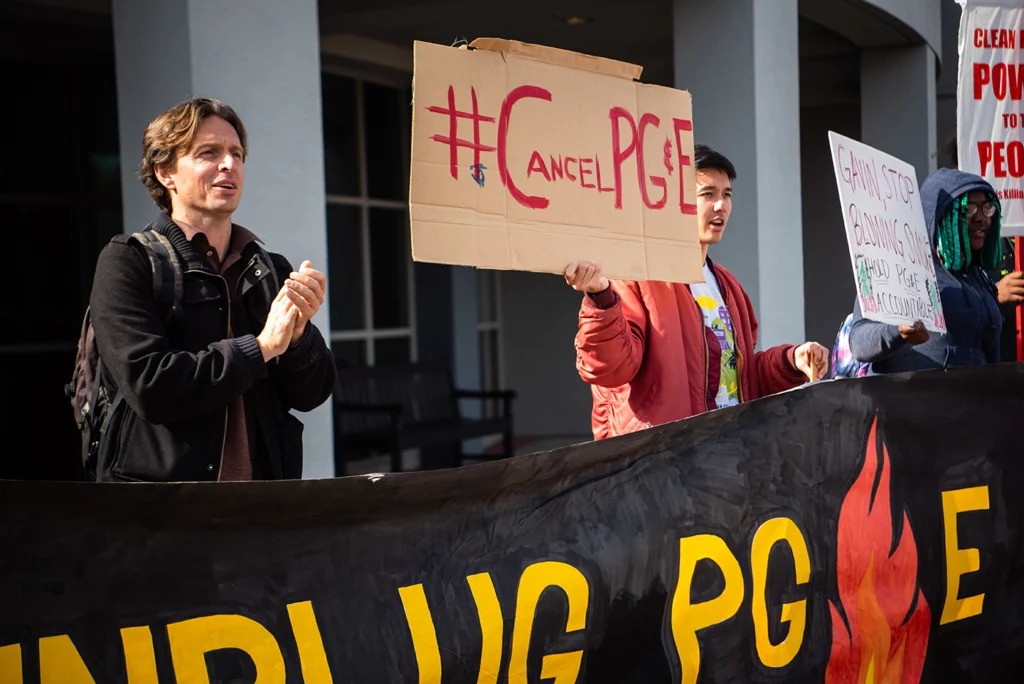
While Reclaim Our Power tries to pry loose PG&E’s stranglehold on California’s energy, the coalition is planting the seeds of an energy future beyond PG&E by supporting a cohort of local communities in designing and constructing their own solar microgrids. The idea is simple: To effectively control the energy system, people need to practice.
That cohort includes fire-affected migrants in Sonoma County, Black high school students in East Oakland, immigrant elders in Oakland Chinatown, and queer and trans people of color acting as land stewards at Shelterwood. Through the cohort, 10 organizations thus far have learned about the energy system, their own consumption needs, and emerging technology.
For some in the cohort – like Shelterwood – controlling their own energy is critical.
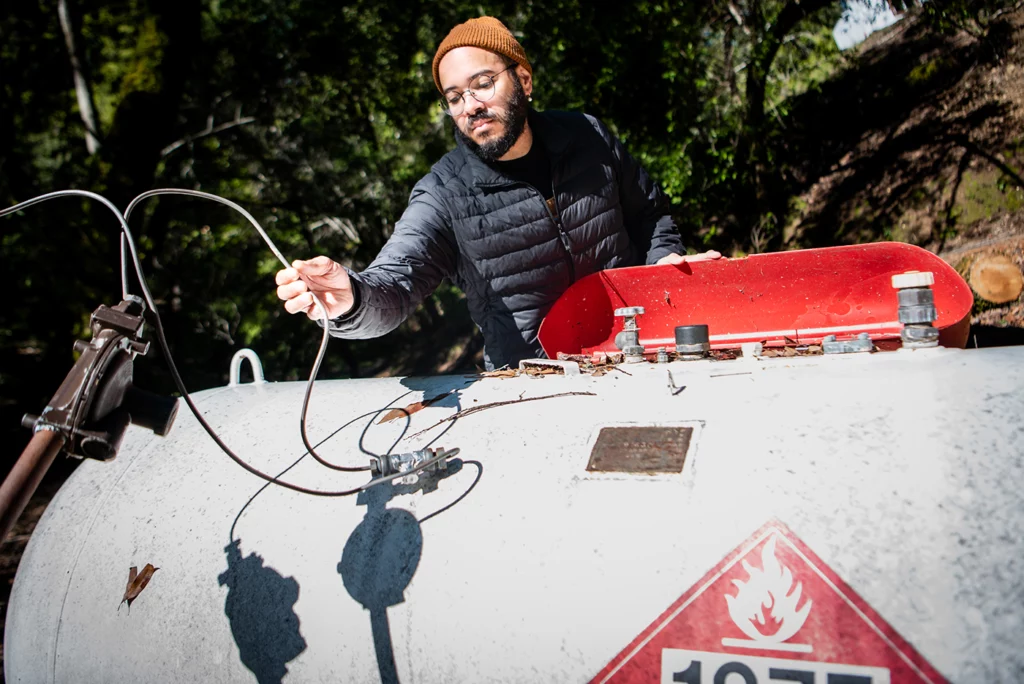
“Shelterwood centers queer and trans folks in ecology. It means a lot, especially in a community in which we’re ostracized into the margins or forced into the cities for protection,” says Layel Camargo, co-founder and co-executive director of Shelterwood, and an Indigenous (Yaqui and Mayo of the Sonoran Desert) trans organizer and cultural worker. “We’re returning our people back to the land.”
But Shelterwood is in the heart of Northern California’s wildfire country, Camargo explains. When it’s hot and windy, PG&E turns off the power without warning. This is a problem for Shelterwood, which sits outside of cellular service and relies on electricity to power satellite phones. Shelterwood also depends on power for its housing, kitchen, retreat center, phones, lights, internet, electric vehicles, and electric tools.
“Rural communities are really at the hands of these monopolized energy companies. In an emergency, without power, we couldn’t call 911. There’d be no way to get information about an evacuation,” Camargo says. “The best way for us to survive out here, and to stay ecologically aligned, is to have as much control of our utilities as we can.”
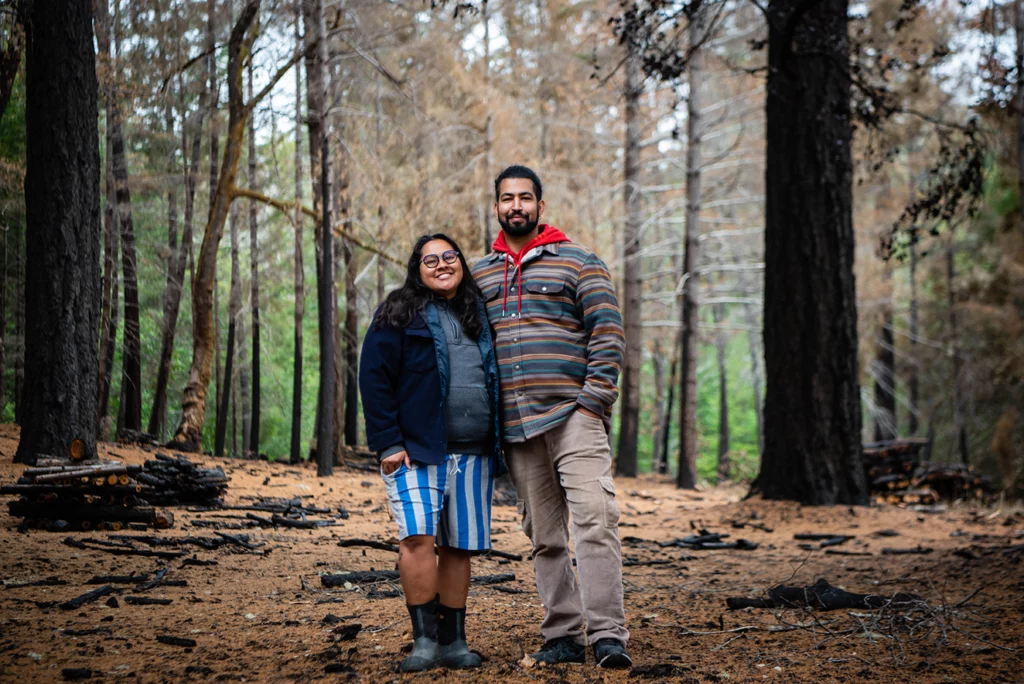
For Shelterwood, building out its own microgrid isn’t just practical, it’s also political.
“When I heard about the counts of manslaughter against PG&E after fires, I felt like it was my responsibility that if I was going to be in charge of electrical infrastructure for a 900-acre forest I would want to be less dependent on a company where our values are not aligned,” Camargo says.
In addition to solar, Shelterwood is also installing a hydro microgrid. This will be used in winter when the sun is less plentiful but the water is flowing through the creeks, streams, and gullies on their land, sometimes up to 25 gallons per minute.
Energy insurrection
California isn’t the only place building out microgrids as part of new energy futures. Puerto Rico has traditionally imported most of its energy, which means that it is both more fossil-fuel intensive and expensive. Importing energy also leaves the archipelago more vulnerable to energy shortages and outages in times of disaster.

When Hurricane Maria hit Puerto Rico in September 2017, it knocked out power to most of the island. The small town of Adjuntas was one of the last regions reached by FEMA, a full month after the hurricane hit. Before the storm, the 45 solar panels on Casa Pueblo, a community center in Adjuntas, had been something of an oddity. But suddenly without electricity on the island, Casa Pueblo became an instant “energy oasis.” People came from all over the island to store refrigerated medicine, plug in their respiratory equipment, and charge their cell phones.
In the immediate aftermath of the storm, Casa Pueblo distributed 14,000 solar lanterns to residents, reducing the risk of fire by candlelight and the vulnerability of elders. It equipped 10 homes with extra energy for dialysis and small refrigerators for insulin and antibiotics to meet critical health needs. With their solar power, they set up a public satellite phone, which people lined up to use to contact their families. They also recorded one-minute messages for residents to play on-air from their solar-powered radio station.
Post-hurricane, Casa Pueblo built out the island’s first community-controlled microgrid. It outfitted an additional 150 homes with solar energy, installed 50 full-sized refrigerators in solar-powered homes, and powered a barbershop, two hardware stores, an agricultural center, two elder homes, the fire station, a restaurant, a pizzeria, five mini markets, a solar cinema, the transmission tower of the radio station, the elementary school, and a pharmacy, among others.
“Everyone has a right to energy, not just those who can pay for or finance solar power,” says Arturo Massol Deyá, executive director of Casa Pueblo.
For these homes and businesses, solar used to be the backup source of energy. Now, Puerto Rico’s main private utility company, PREPA (Puerto Rico Electric Power Authority), is the backup. Energy bills for solar users in Adjuntas have gone down from $85 per month on PREPA (fossil fuels) to $5 per month on solar. Casa Pueblo is now working to bring ‘second life’ used-car batteries to Adjuntas to serve as solar storage.
“Energy is the capacity to do work. We don’t enjoy the wealth made from our work. One way to decolonize Puerto Rico is in practical terms: To create energy independence. We can be producers, not consumers. We don’t need coal and gas. We have sun and wind,” Massol Deyá says. “We’re calling for an energy insurrection. We’re not going to wait for the government. We’re going to unplug ourselves.”
Bringing energy independence to the mainland
The “energy insurrection” in Puerto Rico is an inspiration for many US energy-democracy activists, but especially for Selena Feliciano, national campaign coordinator of the Energy Democracy Project and herself Puerto Rican.
“I have Taíno [the Indigenous peoples of Puerto Rico] roots in my family. Indigeneity understands that energy is not wires, not technology. It’s the sun. It’s what connects us, and keeps us going. It’s only in the last 150 years that we’ve equated energy with infrastructure,” says Feliciano. “The people of Puerto Rico have held steadfast to honoring the tradition of energy beyond technology, and as a basis of resistance.”
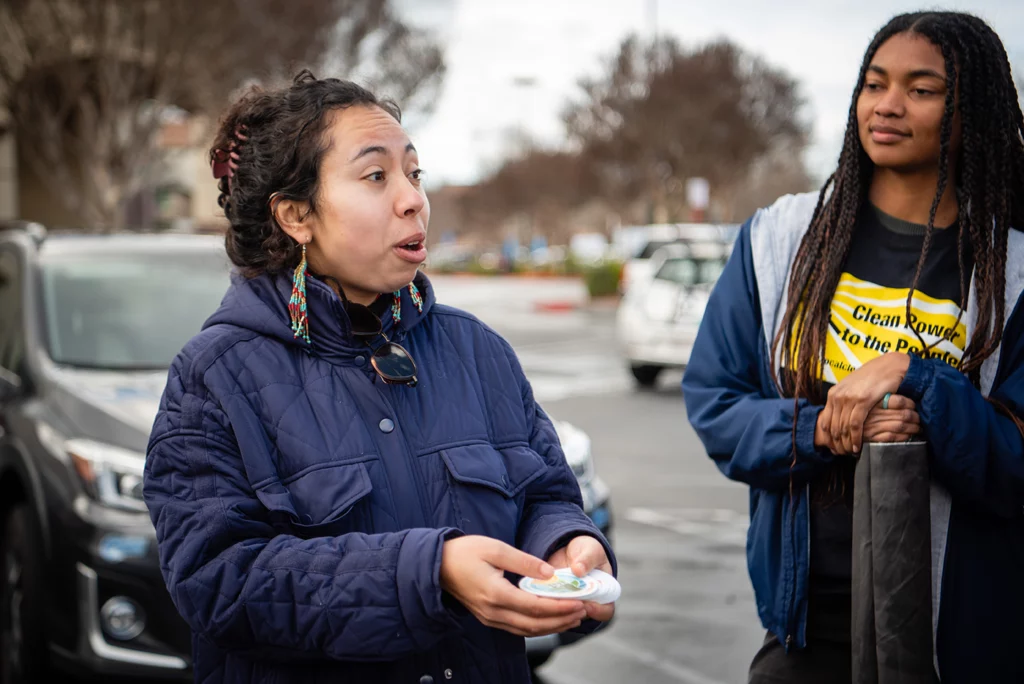
The Energy Democracy Project is a collaboration of 40 frontline organizations in the US to advance energy democracy. Their members hail from Alaska to San Juan, Puerto Rico, and from Jackson, Mississippi, to the Gulf South.
It will take statewide policy change to dismantle private utilities like PG&E and to truly move an energy transition at scale. To get there, microgrids – like at Shelterwood and Casa Pueblo – make concrete improvements in people’s lives, foster familiarity with the technology, bring the conversation into people’s homes, allow to practice self-governance in place, and ignite political imaginations about an energy future beyond private utility companies.
“Energy Democracy rests on community decision-making, but if the community doesn’t know about the available technology or doesn’t know that an alternative is possible, it’s hard to organize around it,” adds Feliciano. “That’s why these first steps are so important—for people to experience these possible configurations and solutions for themselves.”
“The microgrids point to how else we can do it. It creates a real choice between PG&E and this other thing we’ve built. It’s a world that people can fight for, and it is within reach,” Woiwode says. “However, no one technology, microgrids included, is the answer to true energy democracy. If a Google campus, Chevron refinery, and a prison used microgrid technology, but did so in a way that didn’t actively disrupt the racist, extractive, anti-democratic structure of our current system, we would not be any closer to the energy future we all need.”
A just transition in the energy sector isn’t merely a question of technology—replacing coal, “natural” gas, or nuclear power with solar, wind, or hydropower—but rather a political struggle over who governs decisions about the resources it takes to power our lives. Like the double meaning in Reclaim Our Power’s name, it’s not just electric power, but political power.
“It’s not just about the poles, wires, and technology. It’s about the decision points in people’s lives,” Woiwode says.
It is the collective contending with those decision points, say energy democracy activists, that define energy democracy. Unplugging ourselves, as Massol Deyá calls for, doesn’t mean we all act as individuals. Rather, it is the relationships between microgrids that make the system resilient and redundant. Decentralization without democratization would only exacerbate existing inequities.
“Our vision is not that everyone takes their ball and goes home to self-contained units of energy distribution. Energy sovereignty does not mean getting out, vanishing, with wealthy white people disappearing from the system. There needs to be connective tissue,” Woiwode says. “What we want is a mosaic of interconnected community—like the forest.”
The energy justice movement doesn’t seek merely to reform the existing shareholder-owned governance structure of our energy system. It is not a call for a kinder, gentler, slightly less deadly PG&E or PREPA. Rather, it is a reckoning with how the privatization and enclosure of energy has estranged us from earth’s regenerative cycles. It is an invitation to restore our relationship to energy and each other. It is a reminder that there is enough energy for all when we can have a reflexive, responsive relationship to place and earth’s living systems. It is a course correction that devolves governance down to the level of greatest impact so that decisions aren’t made by a few men with MBAs, tucked safely away in corporate offices, but by people in across communities whose lives are most impacted by the tough choices in precarious times. It is an opportunity to practice people-to-people, radical self-governance.
As residents of Lahaina, Maui, tragically learned the past August, when climate disasters like wildfires and superstorms intensify it only further reveals the failures and fractures of our existing energy system that burns fossil fuels in one place and transmits that energy over large swaths of land, according to the whims of a profit-maximizing corporation. But grassroots activists on the ground are building models of the kind of renewable, affordable, interconnected, community-governed energy systems needed for energy democracy. – Rappler.com
BROOKE ANDERSON is a freelance photographer and photojournalist based on unceded Ohlone land in Oakland, California. Her most recent work can be found in YES! Magazine, Teen Vogue, and In These Times. She covers social movements for climate justice and worker power. She is a proud member of the Pacific Media Workers Guild, CWA 39521, AFL-CIO.
This story was produced as part of a Just Transition reporting fellowship with the Movement Generation Justice & Ecology Project.
This story was originally published in Yes Magazine (US) and is republished within the Human Journalism Network program, supported by the International Center for Journalists.

Add a comment
How does this make you feel?

















There are no comments yet. Add your comment to start the conversation.